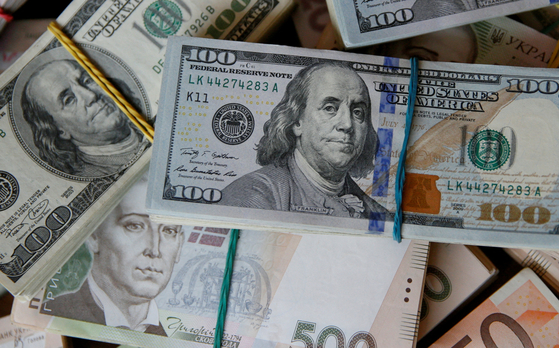Ukraine Mulls Euro Adoption Amid Shifting Geopolitical Tides

U.S. dollars, euros, and Ukrainian hryvnias notes. [REUTERS/YONHAP]
Ukraine is beginning to contemplate moving away from the U.S. dollar, potentially aligning its currency more with the euro due to the fragmentation of international trade and its expanding connections with Europe, according to Central Bank Governor Andriy Pyshnyi’s statement to Reuters.
Possible entry into the European Union, an "enhancement of the EU’s part in securing our defensive abilities," increased instability in worldwide financial markets, and the likelihood of fragmented international trade are compelling the central bank to reassess if the euro should replace the dollar as the benchmark currency for Ukraine's hryvnia, according to Pyshnyi via email.
Pyshnyi added, offering the most straightforward remarks from a Ukrainian official yet regarding a potential change, "This task is intricate and necessitates top-notch, adaptable planning."
The U.S. dollar reigns supreme in worldwide commerce and makes up the bulk of international reserves. Leading nations such as Saudi Arabia and Hong Kong tie their own currencies to the value of the dollar.
However, during President Donald Trump’s tenure, the United States initiated a trade war by imposing potentially record-breaking tariffs not seen since the past hundred years. This action led several analysts to speculate about the future status of the dollar as an international reserve currency.
In the fourth year of battling Russian aggression, Ukraine experienced President Trump briefly halting certain forms of military aid to the nation. Despite pledges from European officials, encompassing representatives from the EU, to bolster Kyiv’s armed forces for long-term stability within Ukraine, advancements have proven challenging.
In the meantime, Ukraine entered into an accord providing the United States priority rights to newly discovered Ukrainian mineral deposits and channeling investments toward rebuilding the country.
Following Trump's comeback at the White House, the US dollar has fallen over 9 percent relative to a mix of significant global currencies due to investors shifting away from American assets. While some specialists caution against linking the dollar’s strength directly with its role as a reserve currency, historical data shows that the holding of dollars has often correlated with security partnerships and defense connections with Washington.
Pyshnyi stated that transactions involving the U.S. dollar still lead across all sectors of the foreign exchange market. However, he noted that the proportion of trades conducted in euros has increased in most areas, albeit "moderately" so far. He didn’t provide further details.
In 1996, Ukraine introduced the hryvnia, and since then, it has utilized the dollar as its benchmark currency over the years.
Following Russia’s invasion in February 2022, the central bank introduced capital controls and set the hryvnia's official exchange rate at approximately 29 to one U.S. dollar. However, Ukraine had to subsequently devalue the currency because of growing fiscal disparities.
In October 2023, the central bank shifted from a strict fixed exchange rate to a more flexible system where the U.S. dollar serves as the benchmark for managing currency interventions and stabilizing fluctuations in the exchange rate. About a year earlier, the European Union had initiated membership discussions with Ukraine and Moldova; however, both countries face a lengthy and challenging journey before becoming full members of the union.
European Union President Ursula von der Leyen stated in February that Ukraine might join by 2030 if it kept up its current rate of implementing reforms within its political and legal systems.
As part of their preparations, Moldova changed the reference currency for the Moldovan leu from the US dollar to the euro starting January 2nd. According to Pyshnyi, stronger ties with Europe along with improved economic conditions could boost investment and consumer activities, leading to an uptick in economic growth to around 3.7% to 3.9% within the coming two years. However, this forecast largely hinges on the progression of the ongoing conflict.
"Rapid resolution of the conflict would undoubtedly be beneficial economically, provided it includes assurances for Ukraine’s safety," Pyshnyi stated.
Despite this, it's important to recognize that the financial advantages of concluding the conflict might only become evident over an extended period.
Ukraine is depending on outside funding to support its wartime expenses. According to Pyshnyi, they anticipate receiving $55 billion this year. This amount aims not just to fill the budget gap but also to establish a financial safety net for future years when assistance might decrease. He stated, “Our projection indicates that Ukraine should get approximately $17 billion in 2026 and around $15 billion in 2027.”
Reuters
Posting Komentar untuk "Ukraine Mulls Euro Adoption Amid Shifting Geopolitical Tides"